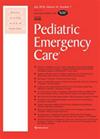探索种族对急诊科处理亲密伴侣暴力的影响。
IF 1.2
4区 医学
Q3 EMERGENCY MEDICINE
引用次数: 0
摘要
目的:研究表明,在遭受亲密伴侣暴力(IPV)的人群中存在种族差异,但人们对急诊科(ED)中处理 IPV 的差异却知之甚少。本研究旨在研究在城市儿科急诊室中,不同种族的患者在向成年看护者提供 IPV 普及教育方面的差异,并探讨医疗服务提供者对种族在这一过程中所起作用的态度。方法我们使用定量数据开展了一项混合方法研究,这些数据涉及 2016 年 1 月至 2020 年 12 月期间向成年看护者提供 IPV 普及教育的比率,以及未向成年看护者提供 IPV 普及教育的文件缺失率。分析比较了电子健康记录中列出的患者种族的两种比率。结果与白人患者的护理人员相比,黑人患者的护理人员更有可能接受过 IPV 普及教育(31.1% vs 27.3%,P < 0.05),与白人患者的护理人员相比,黑人患者的护理人员更有可能缺少未提供教育的文件原因(70.4% vs 53.9%,P < 0.05)。我们对儿科急诊室的护士、执业护士和医生进行了半结构化访谈,从而确定了可能影响这些差异的特定种族偏见。结论我们的研究表明,在儿科急诊室,提供 IPV 普及教育和延迟记录方面都存在种族差异。对定量和定性数据的综合分析表明,识别导致健康差异的偏见和增加医疗服务提供者的多样性非常重要。这项研究的结果可用于为医疗服务提供者提供新的方法,以解决他们的个人偏见,并确保为所有到访急诊室的护理人员提供 IPV 支持资源。本文章由计算机程序翻译,如有差异,请以英文原文为准。
Exploring the Impact of Race on Addressing Intimate Partner Violence in the Emergency Department.
OBJECTIVES
Research highlights racial disparities among those experiencing intimate partner violence (IPV), yet little is known about disparities in addressing IPV in the emergency department (ED). This study was designed to examine variability in offering IPV universal education to adult caregivers across patient race within an urban pediatric ED and to explore provider attitudes regarding the role of race in this process.
METHODS
We conducted a mixed-methods study using quantitative data on rates of offering adult caregivers IPV universal education and rates of missing documentation for when IPV universal education was not offered to adult caregivers from January 2016 to December 2020. Analyses compared both rates by patient race listed in the electronic health record. We also conducted semistructured interviews with ED providers, which were qualitatively analyzed for common themes.
RESULTS
Caregivers of Black patients were both more likely to have received IPV universal education compared with caregivers of White patients (31.1% vs 27.3%, P < 0.05) and more likely to lack a documented reason for not offering than caregivers of White patients (70.4% vs 53.9%, P < 0.05). Our semistructured interviews with nurses, nurse practitioners, and physicians in the pediatric ED were able to ascertain specific racial biases that may influence these disparities.
CONCLUSIONS
Our study showed that racial disparities exist in both offering IPV universal education and documentation deferral in our pediatric ED. Combined analysis of our quantitative and qualitative data shows the importance of identifying biases that cause health disparities and increasing diversity among healthcare providers. The results of this study can be used to inform new methodologies for healthcare providers to address their personal biases and ensure that all caregivers visiting the ED are offered IPV support resources.
求助全文
通过发布文献求助,成功后即可免费获取论文全文。
去求助
来源期刊

Pediatric emergency care
医学-急救医学
CiteScore
2.40
自引率
14.30%
发文量
577
审稿时长
3-6 weeks
期刊介绍:
Pediatric Emergency Care®, features clinically relevant original articles with an EM perspective on the care of acutely ill or injured children and adolescents. The journal is aimed at both the pediatrician who wants to know more about treating and being compensated for minor emergency cases and the emergency physicians who must treat children or adolescents in more than one case in there.
 求助内容:
求助内容: 应助结果提醒方式:
应助结果提醒方式:


